UV Flatbed Printer: Understanding the Difference Between Raster and Vector Graphics
In the realm of digital printing, UV flatbed printers have revolutionized the way we approach print production, offering unparalleled versatility and precision. These printers utilize ultraviolet light to cure inks instantly upon contact with a wide range of substrates, from rigid materials like glass and metal to flexible ones like vinyl and fabric. One crucial aspect that significantly impacts the output quality and application suitability of UV flatbed printing is the distinction between raster and vector graphics. Understanding this difference is vital for anyone involved in graphic design, print production, or simply seeking to harness the full potential of UV flatbed printing technology.

The Fundamentals of Raster Graphics
Raster graphics, also known as bitmap images, are composed of a grid of individual pixels, or picture elements. Each pixel contains color information that, when combined with thousands or millions of others, forms a complete image. Common raster file formats include JPEG, PNG, and GIF. The quality of a raster image is largely determined by its resolution, measured in dots per inch (DPI). Higher DPI means more pixels per inch, resulting in finer detail and sharper images.
Advantages of Raster Graphics
Photo-Realism: Raster images excel at representing continuous-tone photographs and complex textures, making them ideal for printing photographic images.
Color Depth: They can support a wide range of colors, providing rich, vibrant prints.
Widespread Compatibility: Raster formats are universally supported by most image editing software, web browsers, and digital devices.
Limitations of Raster Graphics
Scalability: One of the primary drawbacks of raster graphics is their lack of scalability. Enlarging a raster image beyond its original resolution can lead to pixelation and loss of quality.
File Size: High-resolution raster images can have large file sizes, which may impact storage capacity and processing speed.
Editing Complexity: Editing specific elements within a raster image can be challenging, often requiring advanced photo-editing skills.
Delving into Vector Graphics
Vector graphics, on the other hand, are created using mathematical equations to define lines, shapes, and colors. Unlike raster images, vector graphics are resolution-independent, meaning they can be scaled to any size without losing quality. Common vector file formats include SVG, AI, and EPS.
Advantages of Vector Graphics
Scalability: Vectors can be resized infinitely without any loss of quality, making them perfect for logos, icons, and illustrations that need to be adapted for various mediums.
File Size Efficiency: Vector files are typically smaller than high-resolution raster files, facilitating easier storage and transmission.
Editability: Vector graphics allow for precise editing of individual elements, enabling quick modifications and customizations.
Limitations of Vector Graphics
Photorealism: Vector graphics are not suited for creating photorealistic images or complex textures, as they rely on geometric shapes and lines.
Color Transitions: Achieving smooth color gradients and transitions can be more challenging compared to raster graphics.
Compatibility: While widely supported in design software, some older or less common applications may not fully support vector formats.
UV Flatbed Printing and Graphics Compatibility
UV flatbed printers are capable of handling both raster and vector graphics, but the choice of graphic type will influence the final print outcome and the printer’s capabilities.
Raster Graphics in UV Flatbed Printing
When printing raster images, UV flatbed printers can produce stunning photographic prints with vibrant colors and high detail. The printer’s ability to lay down ink in precise droplets and cure them instantly with UV light ensures that the image quality remains consistent across the print. However, it’s essential to use high-resolution raster files to avoid pixelation and maintain clarity, especially when printing on larger or high-visibility surfaces.
For applications like fine art reproductions, photographic murals, or promotional materials that require high visual impact, raster graphics are the preferred choice. The printer’s resolution and color gamut play crucial roles in accurately reproducing the intricate details and color depth of raster images.
Vector Graphics in UV Flatbed Printing
Vector graphics shine in UV flatbed printing for applications that require crisp lines, sharp edges, and scalability. Logos, text, and geometric patterns are often designed in vector format to ensure they look sharp at any size. UV flatbed printers can interpret vector data and render it with precision, maintaining the clean lines and clarity that define vector graphics.
In industrial printing, where durability and longevity are critical, vector graphics are often used for signage, labels, and product markings. The resolution-independent nature of vectors ensures that the prints remain sharp and legible, even when subjected to wear and tear or viewed from a distance.
Combining Raster and Vector for Optimal Results
In many print projects, the best results are achieved by combining raster and vector graphics. For example, a corporate brochure might feature a vector logo for clarity and scalability, alongside raster images for photorealistic product shots. Design software allows designers to integrate both graphic types seamlessly within a single layout, leveraging the strengths of each.
UV flatbed printers are fully equipped to handle these hybrid designs, applying the appropriate printing techniques for each graphic type. This flexibility makes UV flatbed printing a versatile solution for a wide range of applications, from marketing materials to industrial labeling.
Understanding the difference between raster and vector graphics is fundamental to maximizing the potential of UV flatbed printing. Raster graphics offer photorealism and rich color depth, ideal for images that require intricate detail and texture. Vector graphics, with their scalability and precision, are perfect for logos, text, and geometric designs that need to maintain clarity at any size.
By choosing the right graphic type and leveraging the strengths of UV flatbed printing technology, you can achieve outstanding print quality and durability across a variety of substrates and applications. Whether you’re a graphic designer, print professional, or business owner, mastering the use of raster and vector graphics will empower you to create impactful, high-quality prints that meet your specific needs and exceed your expectations.
